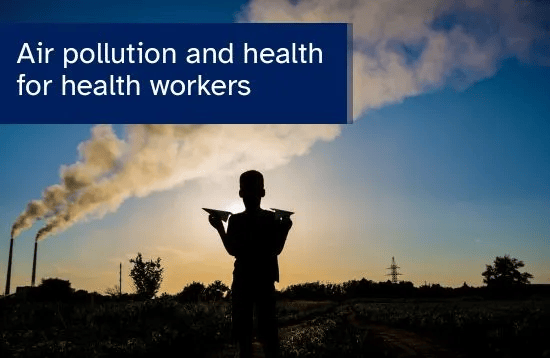
Air Pollution and Health: An Introduction for Health Workers
- Describe what are the main air pollutants and their sources;
- Describe how humans are exposed to air pollutants;
- Explain the main health effects of air pollution and which are the populations at higher risk;
- Recognize the health benefit of both ambient and household air pollution interventions at the population and individual level;
- Outline the leading role health workers can play to address air pollution and health issues with individuals, patients, and communities.
All health workers would benefit from gaining knowledge and skills to protect individuals and communities from air pollution exposure. This course examines the main health impacts of air pollution and which roles health workers can play to protect and promote people’s health.
Air pollution is a major environmental risk causing about 7 million premature deaths per year. These deaths are mostly caused from non-communicable diseases (NCDs) – such as ischemic heart disease, stroke, chronic obstructive pulmonary disease and lung cancer – but also from acute lower respiratory tract infections, such as pneumonia.
To date, air pollution – and more broadly environmental health – is not sufficiently addressed in the curricula of health professionals. Yet, the engagement of the health sector and the health community is pivotal to boost advocacy and political action for clean air. This requires a strong effort by governments and civil society willing to increase the awareness of current and future health workers to tackle the health effects of air pollution.
Approximate course duration: 4 hours.
Languages
This course is available in the following languages: English.
Photo credit: Pond5 / UHDenis
Assessment & Awards
You will receive a Confirmation of Participation upon completing all the modules in this course. Please note that this award does not serve as a professional qualification.
The target audience for this course is health workers which includes care-givers such as medical doctors, nurses, midwives, community health workers, and future health care professionals, as well as public health professionals and other representatives of the ministries of health.
Guidance note
The content of this course has been validated, verified, and is owned by the WHO Air Quality, Energy and Health unit. This course is not a WHO Academy co-produced course. In case of any concerns or feedback on the course content, please share your feedback in the survey form at the end of this course.
Browser and device compatibility
For the best experience, we recommend using the latest version of Chrome, Firefox, Safari, or Microsoft Edge to access the courses.
Produced by the WHO Air Quality, Energy and Health team.

